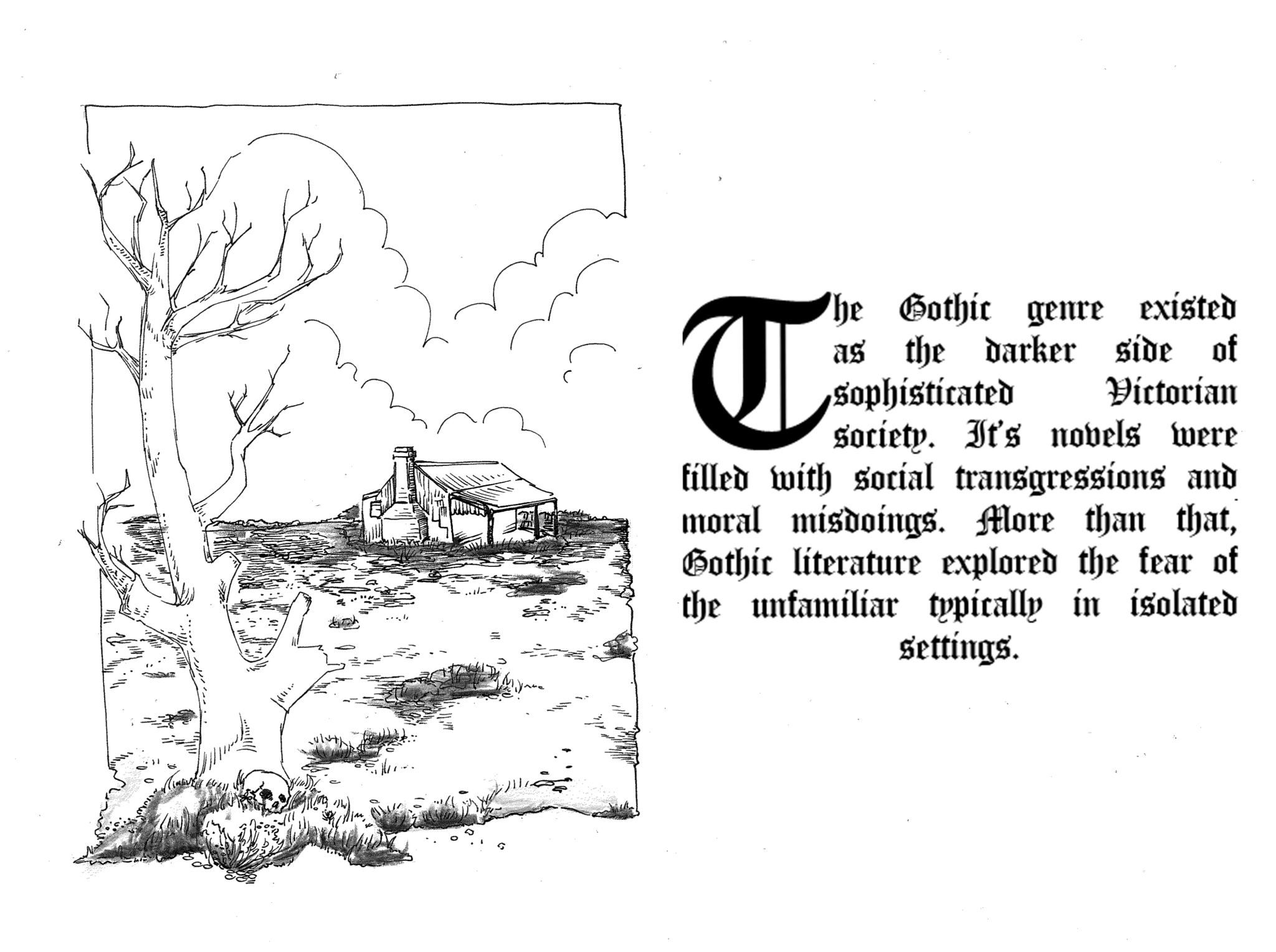The Gothic genre typically conjures images of trapdoors in haunted houses, dirty cobblestone streets disappearing into mist, looming gargoyles, and swooping ravens. The renderings of the supernatural might have been quite extreme, but what made the genre truly horrifying was that for many, it became part of the everyday. The Gothic was all around. An extension of the Romantic period, the study of the genre is usually restricted to its European origin. But beyond that, the Gothic juxtaposes everyday comforts with the fear of the unfamiliar and frequently confronts the horror of isolation. Though rarely discussed, the Gothic mode has had a continuous presence in Australia, lurking beneath the surface.
Following British colonisation in 1770, Australia was perceived as the dark underbelly of the world. The invention of machines in Britain meant that people were no longer needed for agricultural jobs and so they moved to the cities, where crime rose exponentially and slums spread. As America had refused to accept any more convicts, Australia became a vast dungeon for Britain’s criminals — between 1788 and 1868, roughly 162 000 convicts were transported to the colonies in New South Wales and Van Diemen’s Land, mostly for petty crimes.
It was at this time that the Gothic novel was reaching new heights of popularity in Britain. The Gothic genre existed as the darker side of sophisticated Victorian society. Its novels were filled with social transgressions and moral misdoings. More than that, Gothic literature explored the fear of the unfamiliar typically in isolated settings. However, unlike the trap doors and tunnels of The Castle of Otronto, written by English author Horace Walpole in 1764 and considered to be the first Gothic novel, the isolation of the Australian landscape was in its vastness. The sense of displacement and unfamiliarity following European settlement was well expressed through the Gothic mode, which probed the experience of characters trapped in a hostile environment. Moreover, the land itself was imbued with its own psyche, which ultimately reflected that of the colonial experience: isolation, fear of the unknown, and dislocation. The land was harsh and nature was unforgiving.
It is often simpler to understand a society through what it fears, not what it advocates. Gothic novels were the main literature of the Victorian era, following the dominance of poetry from the Romantics, where fears, perversions, and darker realities were articulated. Our literature, similarly, is not quite the Romantic poetry of Banjo Paterson or Dorothea Mackellar that expresses the deeper Australian sentiment — “I love a sunburnt country” — but rather the Gothic telling of its underside, its harsh conditions, perversions and isolated melancholies.
Most commonly labeled as realistic fiction, Henry Lawson’s story The Drover’s Wife expresses the Gothic mode specifically through its renderings of the outback experience in 1892 from the perspective of a woman left alone in an isolated hut to raise her four children, that is, of changed realities and almost supernatural conditions. In the beginning of the story, Lawson introduces us to the bush, with grotesque rather than the usual romantic imagery:
“Bush all round – bush with no horizon, for the country is flat. No ranges in the distance. The bush consists of stunted, rotten native apple-trees. No undergrowth. Nothing to relieve the eye save the darker green of a few she-oaks which are sighing above the narrow, almost waterless creek. Nineteen miles to the nearest sign of civilization – a shanty on the main road.”
The threatening landscape is central to the story as an omniscient basis for the white settler’s sense of unease and alienation. A snake menaces the family, “an evil pair of small, bright bead-like eyes,” and the woman is forced to masculinise herself to protect her children. She later reflects on fighting floods and a mad bullock: “Her surroundings are not favourable to the development of the ‘womanly’ or sentimental side of nature.”
Using setting to reflect the conflict of the characters’ psyche while they remain disconnected from their surroundings is crucial to the Gothic style. In the case of Lawson’s story, the relationship with the land is described in the colonialist language of battle. This is vastly different to the spiritual storytelling of the Indigenous people, who considered themselves to be in harmony with the land.
While the colonial experience made for a specifically Australian brand of the Gothic genre, one that expressed the exhilarating dangers of the landscape and the displacement of the settlers’ experience,the white Australian narrative remains a dark side of this nation’s history. The concept of a ‘new country’ induced a collective amnesia to thousands of years of Indigenous existence with devastating effects. This attitude persists today through the general claim that Australia is too ‘immature’ to have any proper culture. While Australian Gothic literature can be seen as the literary counter to Indigenous existence and storytelling, a colonial overtaking in itself, it allows us to understand our own psyche as benefactors of this land, which is to live with the knowledge of having displaced the Indigenous nation as well as having an inadequate sense of personal history. The vastness of the country only adds to the sense of isolation and disconnect. By exploring the Gothic literature that emerged out of British settlement, not only could we start to understand the various dimensions of our psyche, but we may begin to lift the collective amnesia that discounts the existence of the Indigenous people and perpetuates the damaging statement that Australia has no culture.





